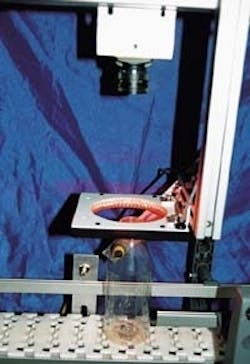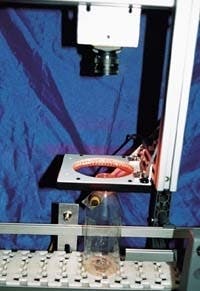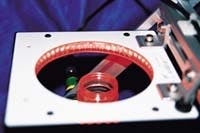Lighting exposes bottle defects
By Lawrence J. Curran,Contributing Editor
When checking fast-moving bottle defects When checking fast-moving bottles, an LED ringlight enables an automated vision system to image neck defects.
The shape and dimensions of the neck area of blow-molded plastic bottles are crucial to proper sealing and purity, especially if the contents consist of food or beverages. But if the plastic is clear, inspecting the neck for defects becomes a challenge. Vision systems have difficulty discriminating between the bottle's neck and other targets in the field of view, which may include objects behind the bottle that can be seen through the clear plastic.
FIGURE 1. During operation of the PTI NV-100 bottleneck-opening vision inspection system, plastic bottles are moved at rates to 350 per minute on a chain belt conveyor (top) and are illuminated by a dark-field LED illuminating ring (bottom) when positioned under a vertically mounted camera (not shown). Image-processing hardware and software check each bottle for neck dimensions and defects.
Packaging Technologies and Inspection (PTI; Tuckahoe, NY), a systems integrator serving the food and beverage industry, among others, has developed a machine-vision platform that has proven essential to the assembly operations of Sherman Plastics (Sherman, TX). Dan Smart, Sherman Plastics' plant manager, reports that PTI's Neck Vision NV-100 bottleneck-opening inspection system "has virtually eliminated all bottles with defective neck openings being shipped to customers" since its installation. That means Sherman Plastic's food/beverage-packaging customers don't have to accept defective returns from their customers because of defective seals.
Sherman Plastics produces clear plastic bottles for a variety of customers, who fill them primarily with milk and fruit juices. Before PTI installed its NV-100 system, Sherman Plastics relied on human visual inspection. This method led to defectively sealed bottles being returned by Sherman Plastics' customers.
Now, the Sherman Plastics conveyor runs at a rate of 120 to 130 bottles per minute, with a spacing of two to three inches between bottles in a linear flow. In this setup, images are captured and processed on-the-fly. In addition, defective containers are rejected before they can be shipped to a packaging customer.
Garry MacNeill, PTI product manager, describes the NV-100 as a high-speed, fully automatic single-camera inspection system that checks for dimensions (diameter) and defects, including unacceptable oval necks and other deformations that would preclude securely attaching a bottle cap. He says the system can accommodate line speeds as high as 350 containers per minute.
MacNeill points out that the difficulty in using machine vision to inspect clear plastic containers was overcome by PTI engineers. They designed a dark-field lighting system using a light-emitting diode (LED) ringlight whose visible light illuminates only the bottlenecks as the bottles pass closely beneath the vertically mounted camera's overhead location.
"The problem associated with inspecting clear containers is that with conventional high-frequency fluorescent light illuminating the container neck, the camera sees too much," explains MacNeill. "We came up with a circular LED ringlight in which the light illuminates only the raised or land surfaces of the bottle neck." In dark-field illumination most of the light is emitted in the horizontal direction and only a small amount of light is emitted in the vertical direction. In this approach, only the object passing through the horizontal field—the bottleneck—is illuminated and captured by the camera (see Fig. 1). The dark-field LEDs came from Advanced Illumination (Rochester, VT). "We designed a small LED ring with a 3-in. diameter," MacNeill reports, "but found after testing that we needed a 6-in. opening to obtain a better field of view."
He says Sherman Plastics had considered an alternative vision system before selecting the NV-100. But the other system encountered difficulties in seeing and imaging too much of the clear bottles during testing. Consequently, the system was withdrawn from consideration.
GETTING THE PICTURE
While dark-field illumination is a critical element in the PTI system, the vision system itself is a Cognex Corp. (Natick, MA) In-Sight 2000 vision sensor (see Vision Systems Design, July 2000, p. 47). Justin Testa, vice president of marketing for Cognex, says the system incorporates vision technology in a stand-alone package. The In-Sight sensor displays a proprietary spreadsheet as the user interface to configure vision applications, eliminating the need for complex programming or the use of an external PC for setup.
FIGURE 2. Key elements of the Cognex In-Sight imaging system include a digital CCD camera, which sends 640 x 480 digitized images to the processor module. The processor board includes a DSP and 16-Mbytes of image-acquisition and processing memory. The processor outputs a standard VGA signal, which can be displayed on a monitor, and also controls the air jet that knocks a failed bottle off the conveyor. The control pad is used to set up the inspection application, allowing a user to select, cut, and past spreadsheet cells and functions, focus the camera, and make changes to the application program.
The In-Sight spreadsheet enables users to select tools and parameters through simple menus and dialogue boxes, then links cells together to locate objects or measure parts. A hand-held control pad enables rapid navigation through the worksheet's cells and menus, allowing a user to quickly configure an application and to make on-the-fly changes during runtime. The spreadsheet is also transparent, enabling a user to display an image of a part—a bottleneck, for example—which shows through the spreadsheet as the neck parameters are set up initially for a given container.
In-Sight comes with a library of vision software tools, including PatFind, which is a part-location tool based on technology that can locate parts despite changes in their orientation, size, or appearance. These tools allow the vision system to work without the need to precisely control the positioning of parts or their illumination. Furthermore, PatFind allows the system to be trained by creating a reference image; the target part is placed under the camera and it acquires an image that's stored for comparison at runtime.
The In-Sight processor uses a DSP chip for vision processing. The sensor provides standard VGA output for an optional live video display, if the user wants to link a PC to the system. Sherman Plastics uses a live video display, but not a PC.
FIGURE 3. Sherman Plastics' installation of the PTI NV-100 bottleneck-opening inspection system shows the CCD camera positioned directly above the dark-field LED illuminating ring. The Cognex In-Sight processor module is housed in the control enclosure.
Housed in a sealed enclosure, the Cognex system comes with a deployment kit, which includes the controller, preinstalled vision software, hand-held control pad, and a 640 x 480 x 8-bit progressive-scan CCD digital camera with an electronic shutter (see Fig. 2). It also provides two RS-232 serial ports, which enable the DSP-based processor to communicate with programmable logic controllers, robots, or other factory equipment, if desired.
The Cognex camera provides a digital interface to the processor unit. This interface reduces the latency between image capture and image processing, which allows the user to maintain line speeds without sacrificing image quality. The progressive-scan CCD, along with the electronic shutter, controls the exposure time to match the available light level and speed of the bottles moving on the conveyor.
PTI added a power supply to the Sherman Plastics system to power the lighting and the rejection solenoids that fire an air jet to knock a failed container off the conveyor. The complete vision system is packaged in a floor-mounted aluminum-profile frame that positions the camera above the standard tabletop chain-belt conveyor (see Fig. 3).
HOT COMMODITY
MacNeill points out that Sherman Plastics' bottles are manufactured on a blow molder and might still be hot when they reach the imaging station. As a bottle cools, its neck area can deform into an oval shape rather than the required circular shape; an oval shape prevents the proper capping of the bottle. The thickness of the land area on the top of the bottle's neck is also critical to successful capping; it prevents leakage after the bottle is filled by the food or beverage packer.
"We trigger images as the bottles move through at a line speed of 130 per minute, looking for land thickness, neck diameter, ovality, or any other deformities that represent a departure from the stored image and its parameters," MacNeill explains. "We run two circular inspection software algorithms—one each for checking the inside and outside of the neck." These tools initially measure the neck diameter at four points and then average the measurements to determine if the neck has deformed.
The bottles need to be approximately centered on the conveyor because the illumination must be evenly distributed across the neck; however, the imaging system can compensate for some variation in placement. The LED ring is always illuminated. A photoelectric cell triggers the camera when a moving bottle trips the cell, indicating that a bottle is in the camera's field of view. The electronic shutter freezes the bottle's motion as the camera acquires an image, digitizes it, and sends the image to memory for processing by the digital signal processor (DSP).
The DSP processes the image, compares it to the stored good image, and checks for image deviations. The neck must fall within a tolerance of 0.010 in. to meet the ovality specification. A failed container is knocked off the conveyor by the air jet, which is automatically triggered by the DSP after the processor has calculated whether the bottleneck is within tolerances.
Gerry Trainque, maintenance manager at Sherman Plastics, notes that the images taken as bottles pass the machine-vision station are transferred to a monitor for visual inspection, as needed. The monitor displays the inside and outside diameters of the neck. However, the DSP calculates whether a given bottle passes or fails, depending on the parameters that were established at system setup for that container. Trainque adds that the parameters can be changed using a joystick, which functions as a keyboard when linked to the processor.
The vision system's key asset is preventing defectively sealed containers from being shipped to customers. As the food-processing industry knows well, disgruntled customers translate into reduced product sales.
Company Information
Advanced Illumination
Rochester, VT 05767
Web: www.advill.com
Cognex Corp.
Natick, MA 01760
Web: www.cognex.com
Packaging Technologies and Inspection
Tuckahoe, NY 10707
Web: www.ptipacktech.com
Sherman Plastics
Sherman, TX 75090
(903) 870-7080


